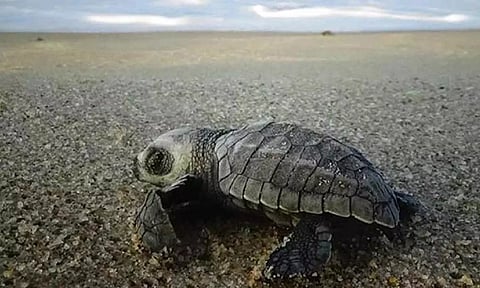

CHENNAI: As the nesting season of Olive Ridley turtles in the state ended, the state forest department has released more than 1.83 lakh hatchlings into the sea, which is the highest number of hatchlings sent to the sea from Tamil Nadu coast.
According to department data, the forest department set up 35 hatcheries across the state and collected more than 2.16 lakh eggs. Out of the total eggs, as many as 1,83,497 eggs hatched and they were released into the sea.
During the 2016-2017 nesting season, only 74,196 hatchlings were released and the state had only 19 hatcheries. In 2021-2022 season, the department set up 22 hatcheries and released 1.72 lakh hatchlings, which was the highest. But the 2022-2023 season has overtaken to record all time high.
Usually, the Olive Ridley nesting season commences in the state in December and would end in April - May. The department engages NGOs and fishermen to collect the eggs and bring them to hatcheries. Eggs will take 45 days to hatch and once the eggs are hatched, they will be released.
Meanwhile, Tree Foundation, one of the organisations working with the forest department has collected 11,873 eggs from Chennai district coast and of which 11,444 hatched. Of the 35,945 eggs collected from Chengalpattu district, as many as 34,127 eggs hatched. It may be noted that the forest department is implementing Joint Community Based Sea Turtle Conservation Programme to involve local communities and conservation organizations.
Dr Supraja Dharini, founder of TREE Foundation, said that undeveloped eggs, piped eggs and dead hatchlings inside the nest will reduce the number of hatchlings released into the sea. Undeveloped eggs could not develop embryos and eggs that hatch partially (heads only come out) is termed piped eggs.
"We are following a scientific based programme to increase the number of hatchlings. We train fishing community every year before the nesting season begins. As this year summer was every intense, we took measures to keep the hatcheries cool as ideal temperature for an Olive Ridley egg to hatch is only 31 degree celcius, but temperature this year crossed 41 degree celcius. Temperature in the hatcheries was regularly monitored using external thermometers, " she explained.
Interestingly, temperature of the hatcheries play a vital role in gender of hatchlings.
If the temperature is between 25 degree celcius to 30 degree celcius, more than 70 per cent hatchlings will be male and if the temperature is maintained between 31 degree celcius to 35 degree celcius, more than 70 per cent hatchlings will be female.
Beyond 35 degree celcius, the eggs will not hatch. Usually, conservators maintain temperature in a way to increase female